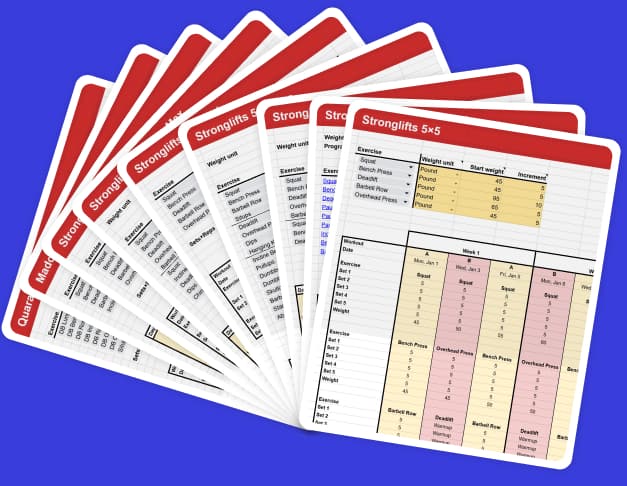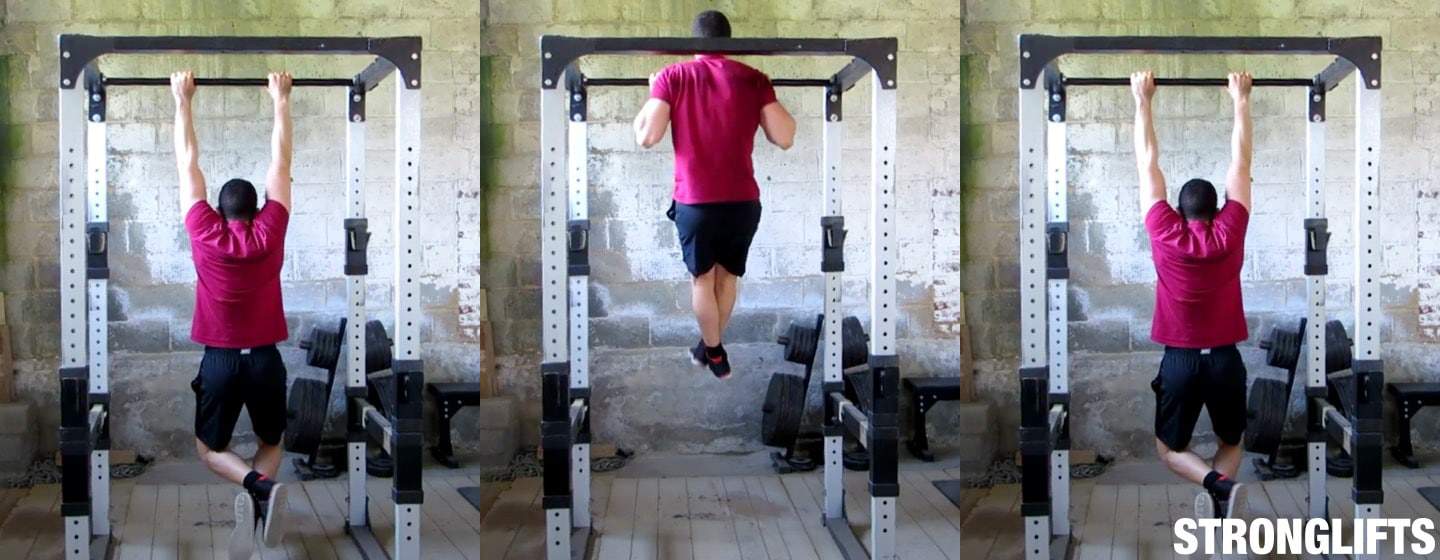
Here’s how to do Pullups with proper form:
- Grab the pullup bar with your palms down (shoulder-width grip)
- Hang to the pullup-bar with straight arms and your legs off the floor
- Pull yourself up by pulling your elbows down to the floor
- Go all the way up until your chin passes the be bar
- Lower yourself until your arms are straight
The Pullup is an upper-body, compound exercise. Your back and arms pull your body up while your abs prevent your lower back from arching. You can emphasize your arms by gripping the bar with your palms facing up. These are Chinups and they’re effective for building bigger arms.
If you can’t do a single Pullup, try Chinups. Grip the bar with your palms facing up, this is easier. If you can’t do a Chinup either, do negatives. Jump up over the bar and lower yourself slowly. You can also use a resistance band or spotter to help you on the way up. But don’t use machines.
Pullups aren’t part of StrongLifts 5×5 by default. You don’t need them to get results. Some people want to emphasize their arms and have time for extra work. If so, add Chinups at the end of workout B. But stay focused on increasing your Squat. It matters most for getting results.
This is the definitive guide to proper form on Pullups. It also covers variations like Chinups.
Join the Stronglifts community to get free access to all the spreadsheets for every Stronglifts program. You’ll also get daily email tips to stay motivated. Enter your email below to sign up today for free.
Introduction
How to Do Pullups
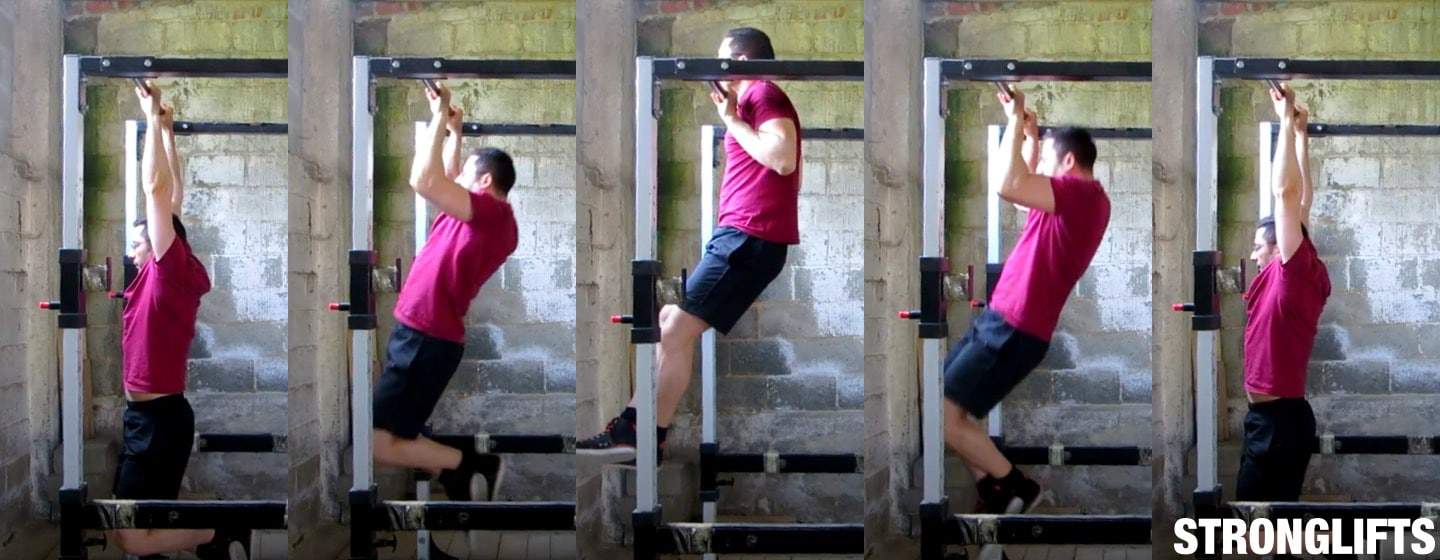
Hang on the pullup bar of your Power Rack to do Pullups. If it has no pullup bar, raise the uprights of your Power Rack or Squat Rack as high as you can. Then put the barbell in the uprights and hang from it to do Pullups. If you have no Power Rack, get a doorway pullup bar. Once you have a bar to hang from, follow these five simple steps to do Pullups with proper form.
- Grab The Bar. Grip it about shoulder-width apart. Full grip with your palms down.
- Hang. Raise your feet off the floor by bending your knees. Hang with straight arms.
- Pull. Pull yourself up by pulling your elbows down to the floor. Keep your elbows close.
- Pass The bar. Pull yourself all the way up until your chin passes the bar. Don’t do half reps.
- Repeat. Lower yourself all the way down until your arms are straight. Breathe. Pullup again.
If you lack the strength to do one Pullup, do negatives. Get your chin over the bar by standing on the bench or the safety pins of your Power Rack. Lower yourself slowly and then jump up again for the next rep. You can also loop a resistance band around your leg to help you up. Or you can ask someone to help you by holding your legs. But don’t use assisted Pullup machines. The best way to get stronger at Pullups is to do Pullups.
Pullup Form 101
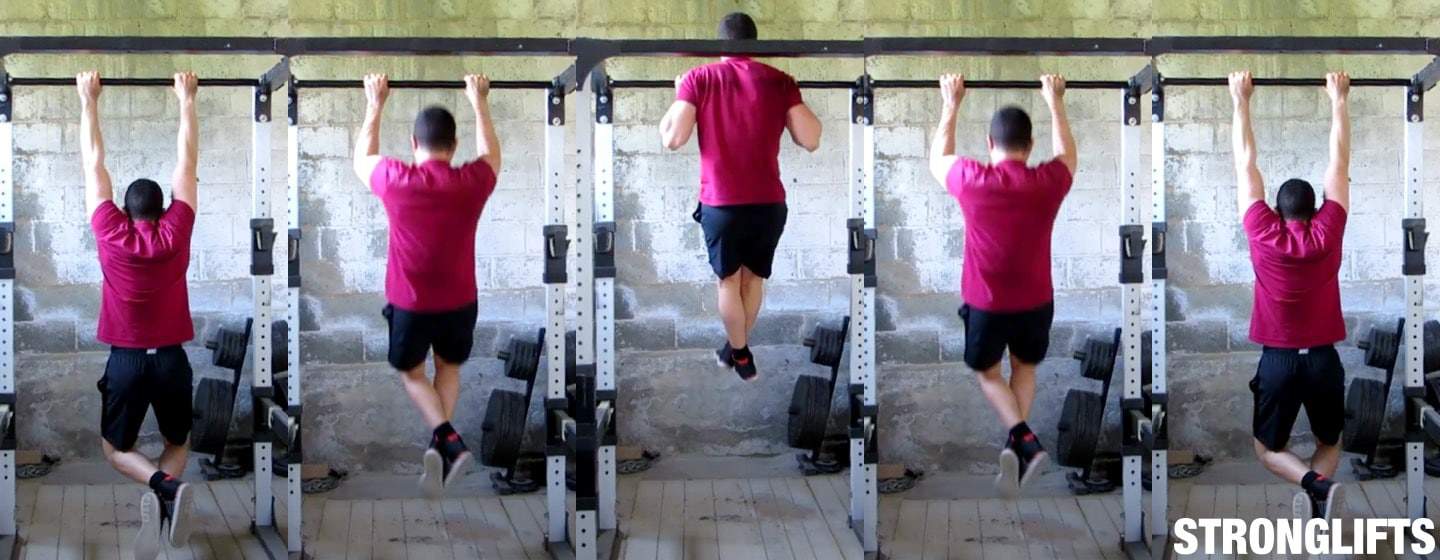
Your build determines your grip width for Pullups. The wider your shoulders, the wider your grip should be. But it can never be wider or narrower than shoulder-width apart. And each rep must start with your elbows locked at the bottom, and end with your chin over the bar at the top. Don’t do half reps of you’ll get half the gains. Use a full range of motion. Follow these guidelines to do Pullups with proper form…
- Grip. Full grip. Face your palms away. Hold the bar high, close to your fingers.
- Grip Width. Your hands should be about shoulder-width apart. Don’t grip too wide.
- Elbows. Keep them 45° in like when you Overhead Press. Don’t flare your elbows out.
- Chest. Raise your chest. Lead with it on the way up. Try to touch the bar with your chest.
- Shoulders. Keep them back. Don’t roll them forward. Don’t squeeze your shoulder-blades.
- Head. Keep it neutral. Look forward. Don’t look at the bar. Don’t reach for it with your head.
- Lower Back. Stay neutral. Straight line shoulders to knees. Don’t over-arch your lower back.
- Legs. Bend your knees to keep your feet off the floor. Cross your legs and squeeze your glutes.
- Bottom. Hang with straight arms and locked elbows. Shrug your shoulders towards the ceiling
- Way Up. Pull yourself up by pulling your elbows down and to the floor. Lead with your chest.
- Top. Get your chin over the bar. Keep your head neutral. Don’t pull it forward to the bar.
- Way Down. Lower yourself all the way down until your arms are straight at the bottom.
- Breathing. Take a big breath at the bottom, hold it at the top, exhale/inhale at bottom
Muscles Worked
Pullups are mostly an upper-back and arm exercise like Barbell Rows. But they train your back differently. Pullups are a vertical movement like the Overhead Press. Barbell Rows are a horizontal movement like the Bench Press. Pullups train less muscles than Barbell Rows because your legs and hips do nothing but hang. Pullups are therefore less full body and more upper-body focused. Here are the muscles Pullups work…
- Upper-back. Your latissimus dorsi aka lats pull your upper-arms down to pull yourself up. Your lats are your broadest back muscle that create a “v-shape” look. Pullups also work your traps, rear shoulders and various small muscles in your upper-back.
- Arms. Your biceps bends your elbows to pull yourself up. Your biceps works hardest when you do Chinups with you palms up. Your forearms muscles also work to bend you elbow and to hold you on to the bar. Your triceps pulls your elbows back towards your torso.
- Abs. Your ab muscles prevent your lower back from arching while you pull yourself up. They maintain a straight line from your shoulders to your knees. This works the “six pack” muscle that runs over your belly, your rectus abdominus. Eat right and they’ll show.
You can add Pullups as an assistance exercise to StrongLifts 5×5. For more info, read this.
Pullups vs Chinups
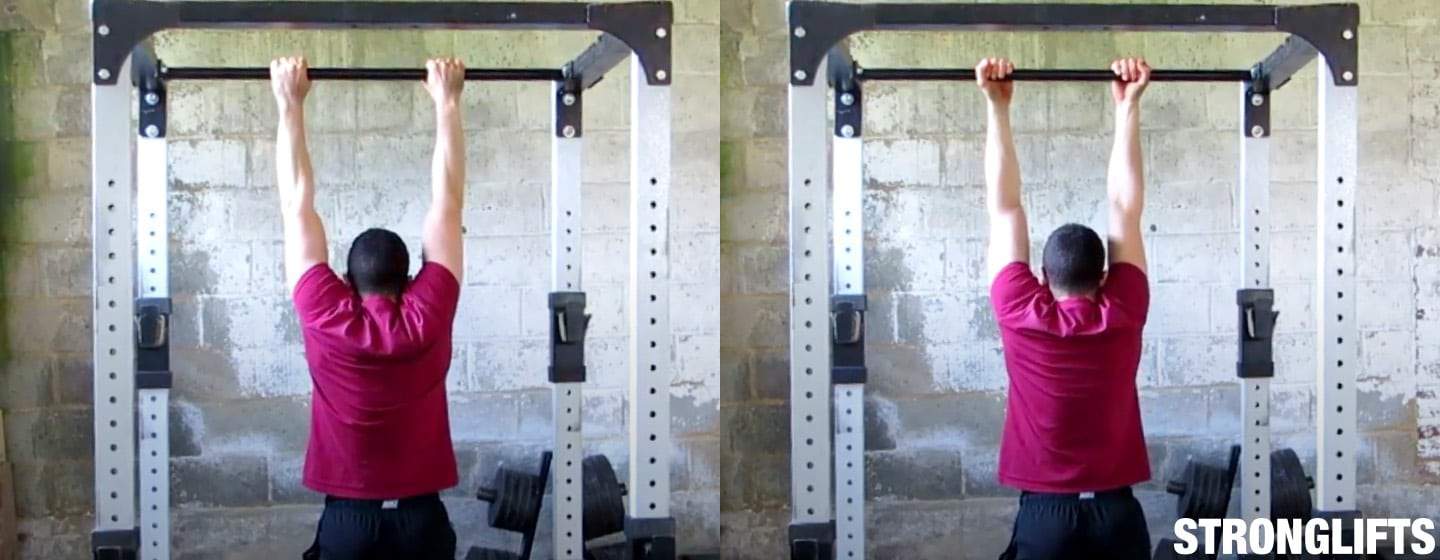
Pullups and Chinups work the same muscles. But the different grip changes which muscles do most of the work. Chinups with palms up work your biceps more. Pullups with palms down work your back more. Chinups are easier than Pullups because you can use more arms. If you can’t do one Pullup, try Chinups – you might be able to do one. If you want bigger arms, do Chinups instead of Pullups.
Chinups beat biceps curl to build bigger arms. Chinups force you to lift more weight. They force you to lift your own body-weight. A guy weighing 75kg like me can easily build the strength to do one Chinup. I can do weighted Chinups with a plate of 20kg for reps. That’s 95kg total. Try to Biceps Curls 95kg or even 75kg. More weight is always better for gaining muscle. If you want bigger arms, do Chinups instead of curls.
You can add Chinups as an assistance exercise to StrongLifts 5×5. For more info, read this.
Pullup Technique
Grip
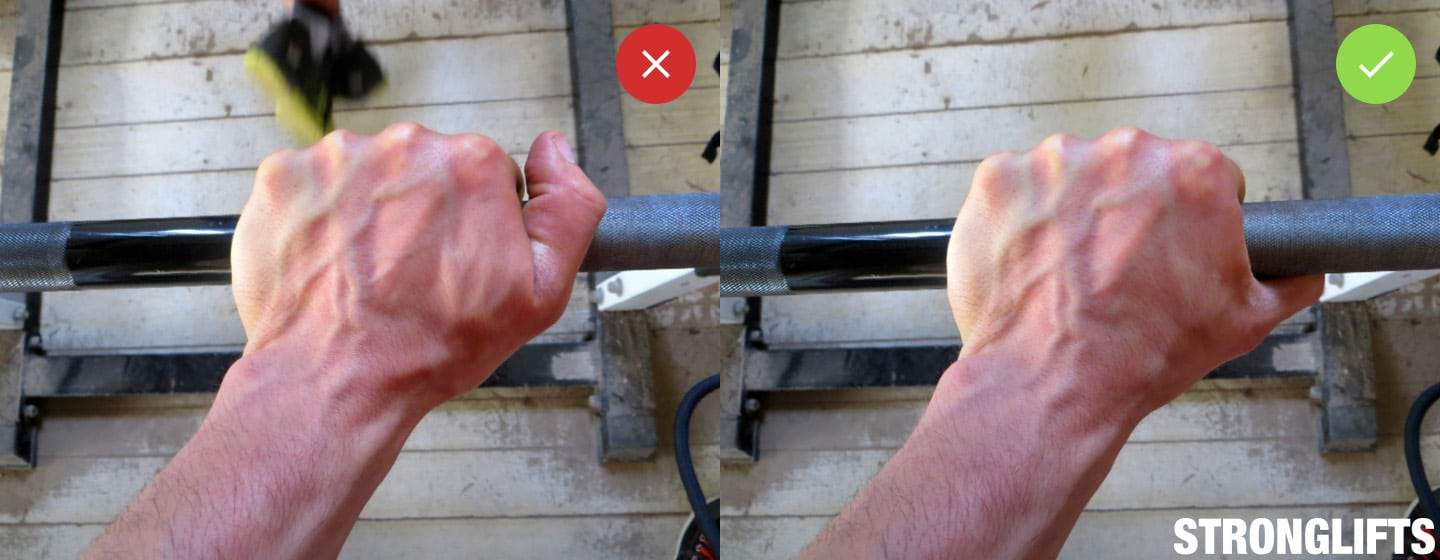
Full Grip. Put your thumbs around the bar. Squeeze the bar hard so it can’t move and so you can’t slip. The harder you squeeze the bar, the more your arms and shoulders muscles contract. The harder they contract, the more strength you have and the easier Pullups become. The thumbless grip can help you “feel” Pullups better. But you’ll be stronger with the full grip because you can squeeze the bar harder. Go full grip.
Grip The Bar Low. Hold the bar high in your hands, close your fingers. The bar should rest on top of your main calluses. This is the same grip you should use on Deadlifts. The bar will trap less of your skin when you hold it close to your fingers. This stops your hands from hurting and reduces how many calluses you get from Pullups. Don’t grip the bar mid-palm. Hold it higher, between your palm and your fingers.
Double Overhand. Hold the bar with your palms facing up for Pullups. This is the pronated grip that targets your upper-back and lats. You can also grip the bar with your palms down and do Chinups. This supinated grip works your upper-back and lats muscles too, but it uses your biceps more. If you want to emphasize your arms or can’t do a single Pullup, do Chinups. They’re easier. Otherwise stick with Pullups.
Grip Width
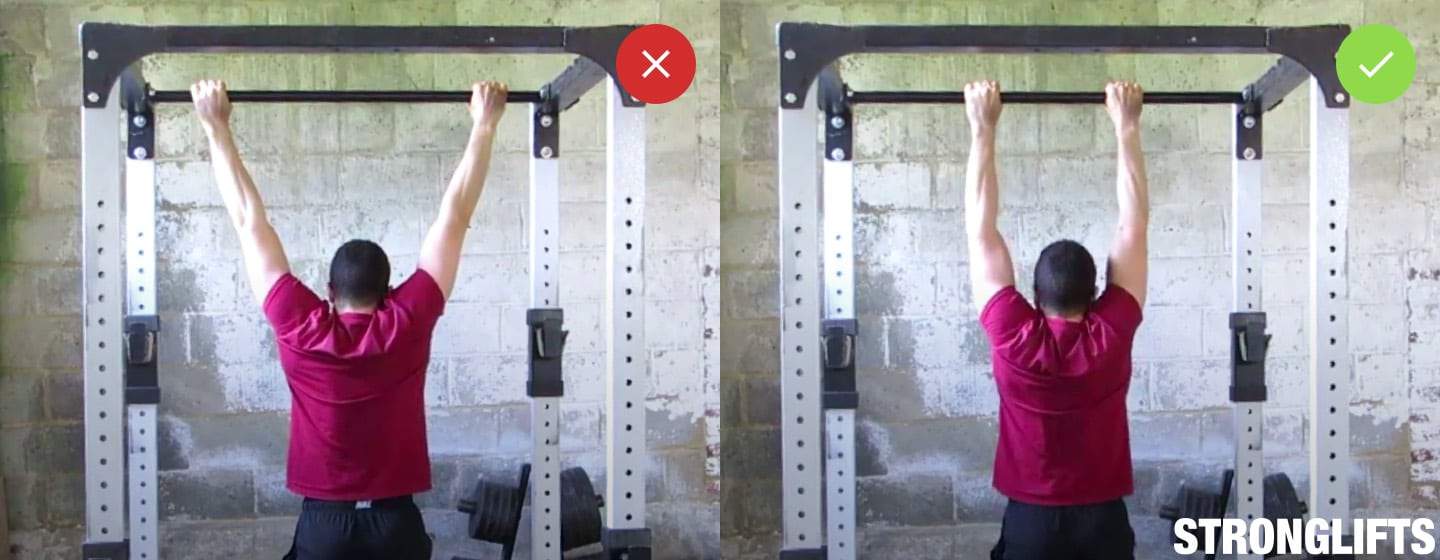
Narrow Grip. Grip the bar about shoulder-width apart when you do Pullups or Chinups. Your hands should be just outside your shoulders when your chin passes the bar at the top. This means your grip width for Pullups should be about the same as when you Overhead Press. The exact grip width depends on how wide your shoulders are. But your arms should be close to vertical when you hang on the bar.
No Wide Grip. Gripping wide shortens the range of motion. It makes Pullups easier because you pull yourself up over a shorter distance. But it can also make you flare your elbows and hurt your shoulders. Plus you want to work your muscles through a full range of motion, not a half one. This strengthens your lats and increases the size of your back. A wide grip is unnecessary and counter-productive. Go narrow and heavy.
Elbows
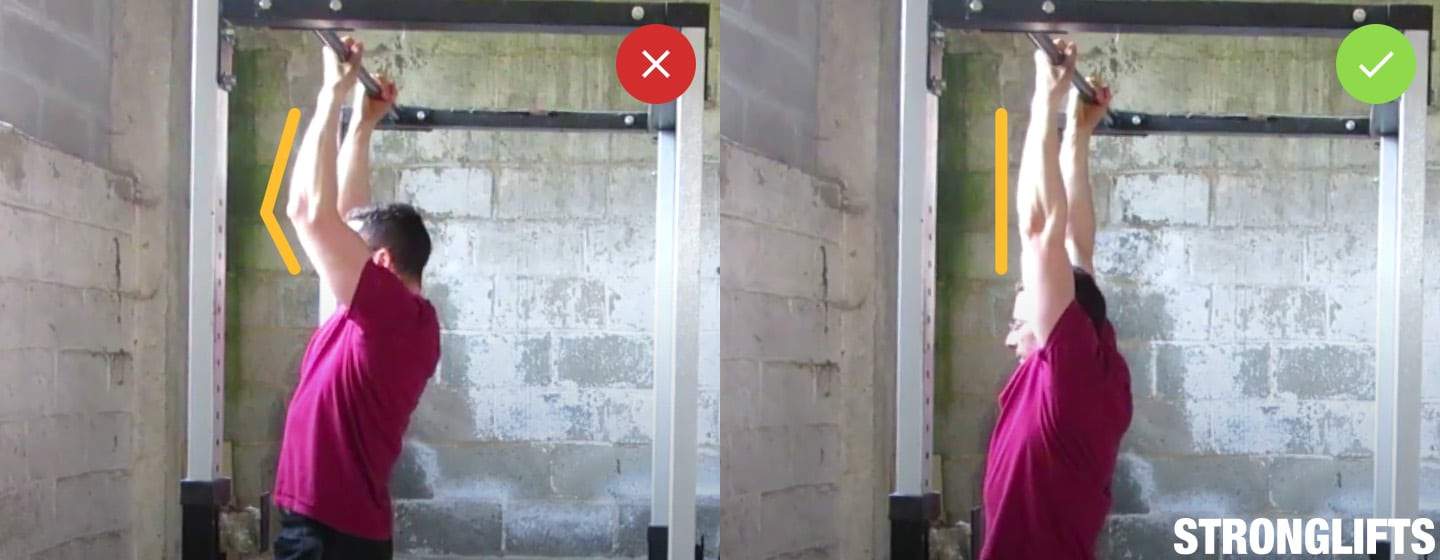
Lock At The Bottom. Start each rep with locked elbows. The rep never counts if your arms started bent at the bottom. Your arms must be straight before you pull yourself up. Hang on the bar with your elbows locked. Lower yourself all the way down between reps. This will be harder because the range of motion is longer. But it’s not bad for your elbow joints as long as you don’t hyper-extend. Lock your elbows gently.
Elbows 45°. Pull yourself up by driving your elbows down into the floor. Keep your elbows close to your torso. Your elbows shouldn’t flare and end perpendicular to your torso at the top. They should touch your ribcage/lats and point about 45° in. You must grip the bar narrow, just outside your shoulders, for this to work. If you do it right, the top position of the Pullup will look like the bottom position of your Overhead Press.
Chest
Lead with Your Chest. Pull yourself up by leading with your chest. Try to touch the bar with your upper-chest (your collarbone). Don’t worry if you can’t touch the bar with you chest. As long as your chin passed the bar, the rep counts. The goal is to avoid your shoulders to roll forward. You want to keep them back so you don’t injure them. The trick is to lead with you chest on the way up of Pullups.
Shoulders
Keep Your Shoulders Back. Don’t let your shoulders roll forward during Pullups or Chinups. Rolling your shoulders forward can result in shoulder pain. Keep your shoulders back. You don’t have to squeeze your shoulder-blades together to do this. Instead, pull yourself up by leading with your chest. This will keep your shoulders back. Don’t do Pullups with bad form just to get more reps. Do it right so you don’t hurt yourself.
Head
Look Forward. Don’t look at the ceiling or the bar. Don’t look aside or tilt your head. Look forward instead. Keep your head inline with your torso. This way there’s no squeezing of the spinal discs in your neck. You’re less likely to get neck pain from doing Pullups. Look at the wall in front of you. If there’s a mirror, look through it. You should have a straight line from head to hips when you do Pullups or Chinups.
Lower Back
Natural Arch. Keep your lower back neutral. It shouldn’t be flat but not over-arched either. Instead, you should do Pullups with a natural arch in your lower back like when you stand. Don’t let it hyper-extend or you’ll squeeze your spinal discs and may get back pain. Stay neutral by keeping your ribcage down. Squeeze your abs and straighten your legs on the way up. Keep a straight line from shoulders to knees.
Legs
Bent Knees vs Straight Legs. Pullups with straight legs is better because you can keep your lower back neutral more easily. But few gyms have high pullup bars. Most Power Racks are too low to do Pullups with straight legs without your feet touching the floor. This is why I do Pullups with bent knees. I do however let my lower legs drop on the way up to keep my lower back neutral. Try it.
Bottom

Straight Arms. Hang with straight arms and locked elbows before you pull yourself up for the first rep. Let your back and lat muscles stretch. Let your shoulders shrug towards the ceiling. Take a big breath, hold it and pull yourself up by driving your elbows down. Then lower yourself all the way down until your arms are locked again. Let everything stretch. Don’t start any rep with bent elbows. It’s cheating.
Way Up
Elbows Down. Pull yourself up by driving your elbows down to the floor. Keep your elbows 45° in, don’t let them flare. Keep your torso close to the bar. The shorter the distance between your hands and your shoulders, the easier to pull yourself up. Lead with your chest on the way up. Try to touch the bar with your upper-chest. It’s okay if you can’t, as long as your chin passes the bar the rep counts.
Top
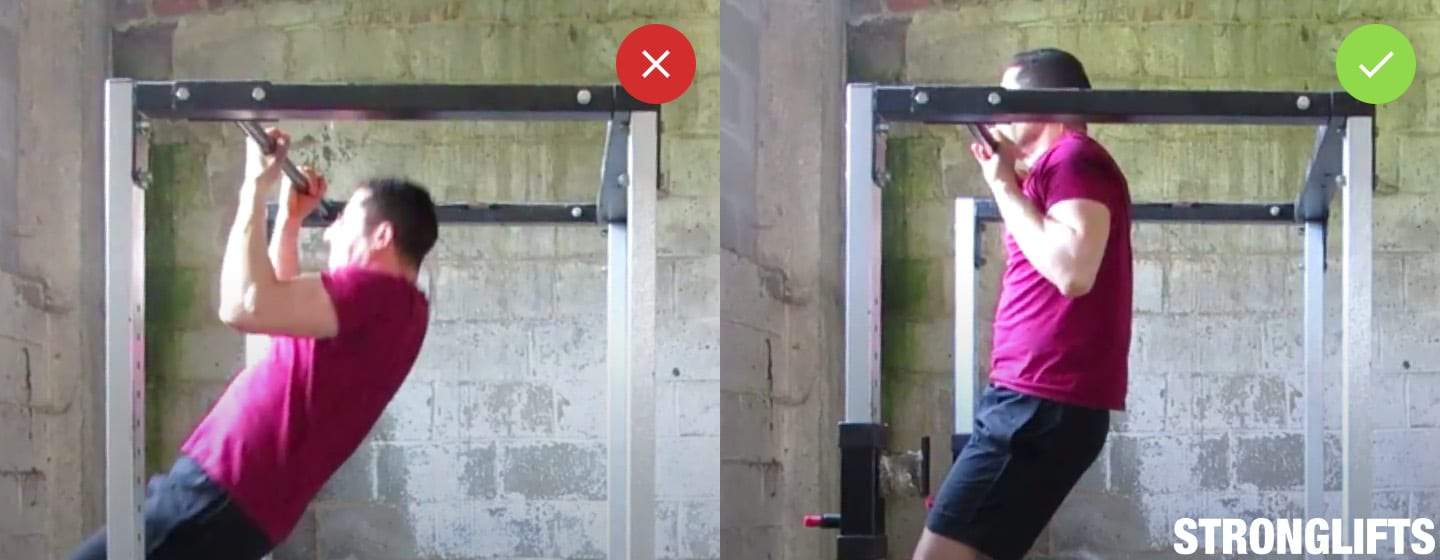
Chin over Bar. Pull yourself all the way up until your chin passes the bar. Forehead against bar doesn’t count. Nose against bar doesn’t count either. Both shorten the range of motion. It’s like doing a half Squat. You get half the result because your arms don’t get a full contraction at the top. Get your chin over the bar without reaching with your head forward. If you can’t do it, use a resistance band to help you.
Way Down
Lock Your Elbows. Lower yourself all the way down until your elbows are locked. Your arms must be straight when you hang between reps. Never start the next rep with bent elbows. The rep doesn’t count if your elbows weren’t locked because this shortens the range of motion. It’s like doing a half Squat. Go all the way down. As long as you don’t hyper-extend your elbows but lock gently, your elbows will be safe.
Breathing
Breathe at The Bottom. Hang on the bar with straight arms and your feet off the floor. Take a big breath, hold it and pull yourself up. Get our chin over the bar. Then lower yourself all the way down until your arms are straight. Exhale at the bottom and let everything stretch. Take a second to gather yourself then take a big breath and pull yourself up again. Repeat until your set is over.
Common Issues
Cheating
Cheating on Pullups is shortening the range of motion by doing half reps. Every rep must start with your arms straight at the bottom. And every rep must end with your chin over the bar at the top. This works your back and arms muscles through a full range of motion. It builds the most amount of strength and muscle. Half-Pullups are easier like half Squats are easier. But that’s also why they’re less effective.
The first way to do half reps on Pullups is by starting each rep with bent elbows. This shortens the range of motion. It takes work away from your back muscles. And it builds dangerous habits for the Deadlift where each rep must start with locked elbows to avoid biceps injuries. Lower yourself all the way down until your elbows are locked. Let your back stretch. Shrug your shoulders. Then pull yourself up from a dead hang.
The second way to do half reps on Pullups is by failing to get your chin over the bar. Forehead or nose against bar doesn’t count. Both shorten the range of motion at the top. They take work away from your arm muscles. Your biceps isn’t getting a full contraction. It won’t get bigger this way. The ideal is to get your upper-chest (your collarbone) against the bar. The minimum is to get your chin over the bar. That’s proper Pullup form.
The other way to cheat Pullups is using your hips. You can create momentum by swinging your hips and legs on the way up. These Kipping Pullups allow you to do more reps. But they don’t get you stronger at dead hang Pullups. Worse, kipping can destroy weak shoulders. Don’t swing your hips and cheat to get more reps. Use proper form. If you lack the strength to do Pullups with proper form, follow the tips below.
Can’t Do One Pullup
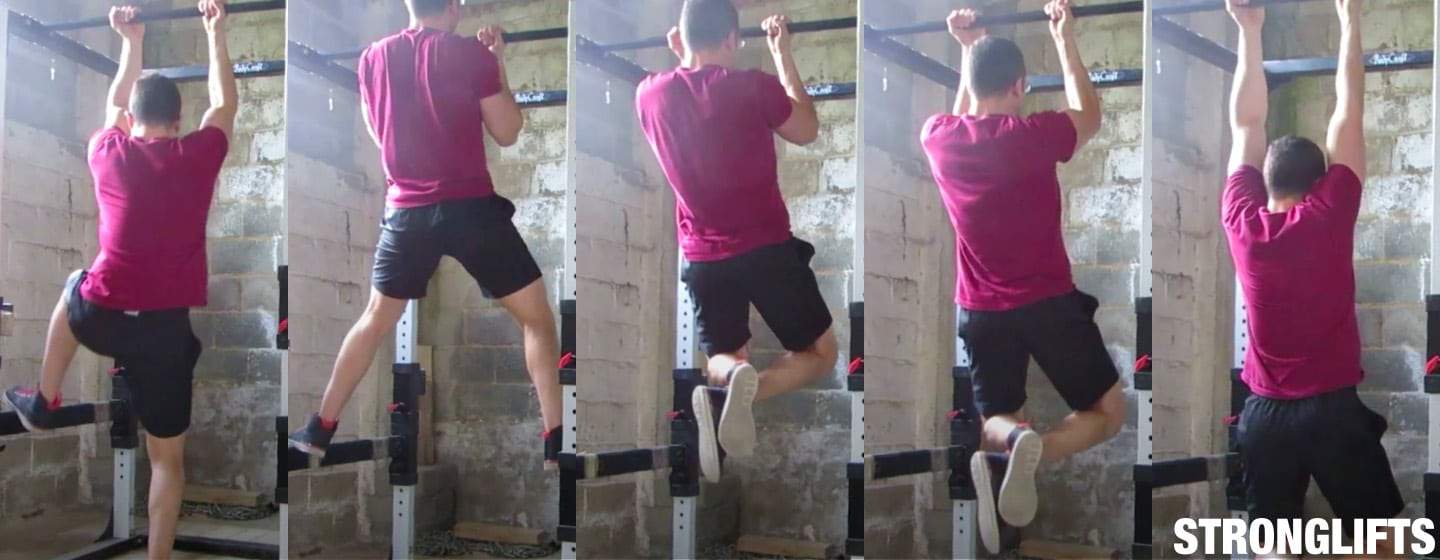
Pullups are hard because they force you to lift your body-weight from day one. Barbell exercises like Squats are easier to scale. If you can’t Squat a weight that equals your body-weight, you simply remove plates from the bar. Worst case you start with the empty bar. But the only way to reduce the resistance on body-weight exercises like Pullups is to lose weight. This isn’t practical. So you need other ways to make Pullups easier.
Try Chinups first if you can’t do a single Pullup. Chinups are easier than Pullups because they use more arms. Grip the bar with your palms facing you and try to pull yourself up. If you can’t do it, that’s okay, move to the next paragraph. If you can do it, stick with Chinups. Do three sets for as many reps as you can with proper form. Try to do one rep more each workout. When you can do five Chinups, you can do one Pullup.
If you can’t do one Chinup, do negatives. Get your chin over the bar by standing on your bench. Lower yourself slowly until your arms are straight. Jump up again for your next rep. Everyone is stronger on the way down (the negative) so you can do this. Do three sets of as many reps as you can with proper form. But don’t overdo it or you’ll get sore arms. When you can do 10 negatives with good form, you can do one Chinup.
You can also use assistance to pull yourself up. The easiest way is to ask someone to hold your legs while you do Pullups. I did this when I joined the gym in 1999 and couldn’t do one Pullup. My trainingpartner held my feet while I pulled myself up. Eventually I could pull myself up without his help. The trick is to do most of the work yourself. Don’t pull yourself up by pushing your feet in his hands. Use your back and arm muscles.
If you have nobody to help you, use a resistance band. Loop it around one leg and the bar. The band will stretch when you hang from your arms. It will help pull yourself out of the bottom, hardest position. Unlike the assisted Pullup machine, the band doesn’t help you at the top. It only helps at the bottom. Your arms must do most of the work to get your chin past the bar. And you must balance yourself unlike on a machine.
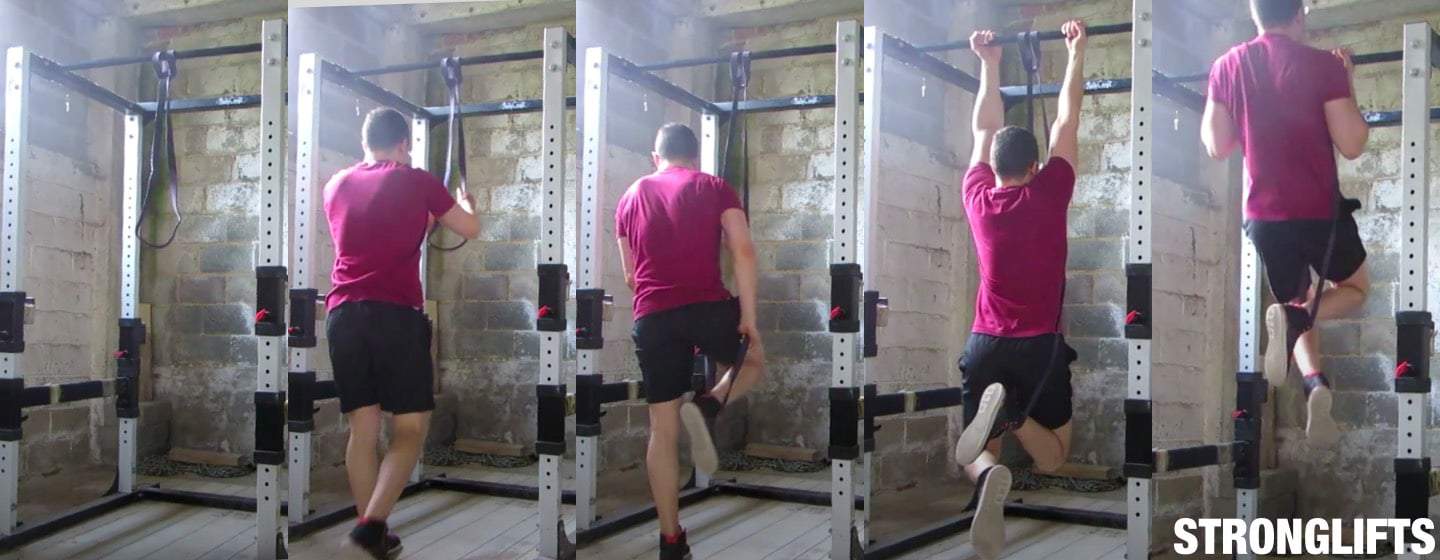
The resistance bands you need for Pullups are 1m/41″ long and 4.5mm thick. Their width varies but the wider they are, the more assistance you get. People of average size like me (I’m 75kg) need less assistance. We’re usually fine with a medium resistance band. Bigger guys need more help. If you weigh +100kg/220lb, you need a large resistance band (or a medium + small one).
Here are some resistance bands I recommend…
- Serious Steel Bands – blue #3 if you’re average size, add the red #2 if you’re big
- WODFitters
The quickest way to get stronger at Pullups is to do daily Pullups. Get a doorway pullup bar at home. I have one next to the desk where I work. Do one Pullup everytime you pass the bar. Use proper form and stay away from failure. After a few weeks you’ll be able to do several Pullups in a row. Pavel Tsatsouline calls this “Greasing The Groove”. Frequent and specific practice is the quickest way to get stronger at Pullups.
Too Heavy for Pullups
The heavier you are, the more weight you have to pull up and the harder Pullups will be. This is why gymnasts are almost always small. Smaller usually means a lower body-weight. This gives you an advantage on body-weight exercises like Pullups where your weight acts as the resistance. But it doesn’t mean you’ll never be able to do one Pullup if you’re big. It will be harder, sure. But you’ll get stronger if you do the work.
Here’s a video of the strongman Jesse Marunde doing 21 Pullups at a body-weight of 140kg/310lb. His form isn’t the best. His chin doesn’t pass the bar. He uses a wide grip which further shortens the range of motion. And he swings his hips on the way up. But I’m sharing this anyway because big guys often use their weight as an excuse. This video proves it is possible to do Pullups even if you’re a heavy weight.
http://youtu.be/BAUUTwoimpI
The first step to get stronger at Pullups is therefore to stop using your weight an excuse. The next step is to stop avoiding Pullups. Don’t wait until you’ve lost weight. Don’t do Lat Pulldowns or the Assisted Pullup Machine. Do Pullups. Because the fastest way to get stronger at Pullups is to do Pullups. If you can’t do one, do negatives or use a heavy resistance band. And get a doorway pullup bar at home so you can do daily Pullups.
Pullup Variations
Chinups
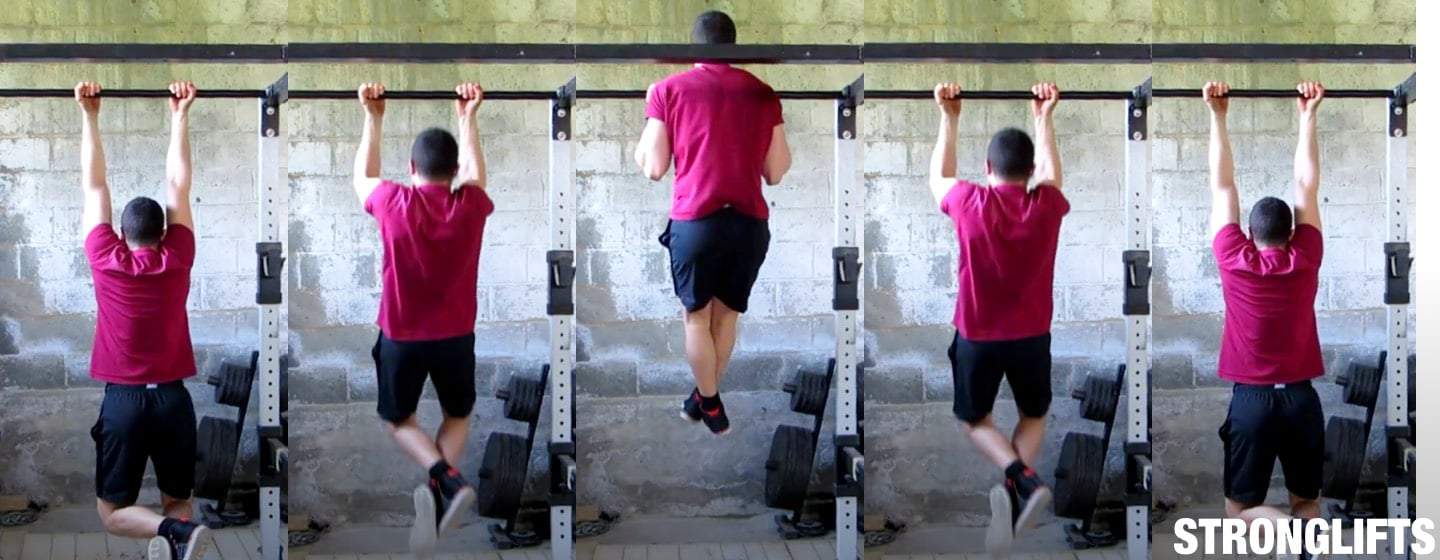
Chinups are Pullups using a supinated grip. You grip the bar with your palms facing up instead of down. You then pull yourself up. Chinups are easier than Pullups because they use your biceps more. They use more muscle. If you can’t do a single Pullup, try Chinups instead. If you want bigger arms, do Chinups. Note that Chinups work your upper-back muscles too. It just uses more biceps.
Technique on Chinups is same as on Pullups. Your hands should be shoulder-width apart. A wider grip shortens the range of motion. It also rotates your arms more out. This stresses your wrists, elbows and shoulders. It can cause pain. Grip the bar narrow. Your hands should be just outside your shoulders when your chin passes the bar at the top. If Chinups feel uncomfortable because you’re inflexible, stick with Pullups.
Weighted Pullups/Chinups
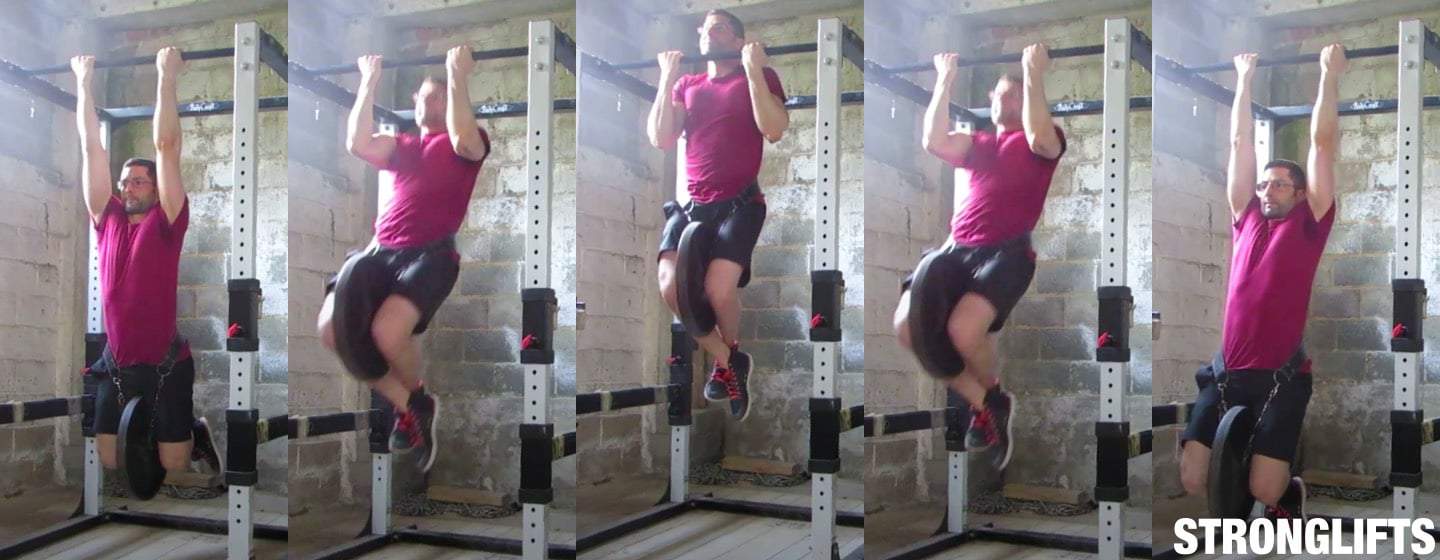
Weighted Pullups are Pullups with extra weight. You wear a belt with plates hanging on a chain to your waist. You then pull yourself up. The extra weight keeps Pullups challenging once you can do more 10 reps with good form. Doing Pullups for higher reps builds endurance, not strength and muscle. You don’t build big legs by doing 50 reps Air Squats. You add weight. Same for Pullups: you switch to Weighted Pullups.
The easiest way to add weight for Pullups is using a dip belt. This is a belt with a chain. The belt goes around your waist. The chain goes inside the holes of your plates. The chain hangs between your legs to the belt around your waist.
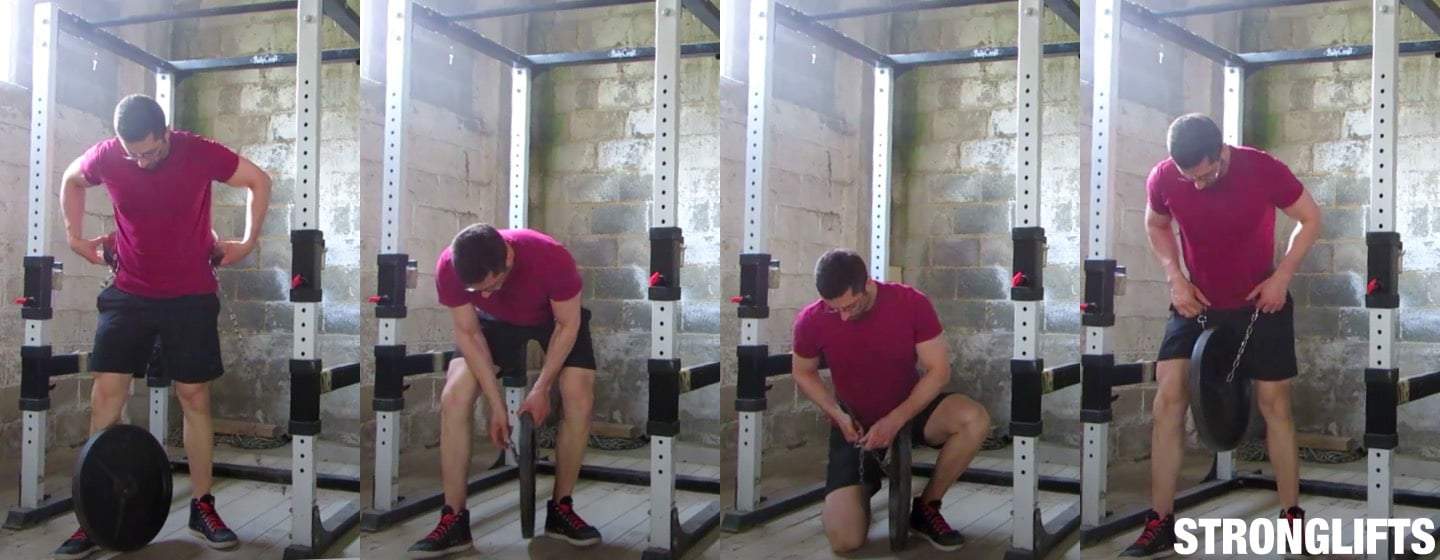
Quality dip belts easily handle 80kg/150lb and more. I don’t recommend putting a chain on the belt you use for Squats and Deadlifts, it will damage it. Get a dip belt instead. Suggestions:
I also don’t recommend holding a dumbbell between your feet. This only works with light weights. Heavy weight will drop out of your feet. Even if you can hold it, it only works if your pullup bar is high so your feet don’t touch the floor. You can’t hold the dumbbell between your feet with bent knees. And you can’t straighten your legs if you do Pullups inside a low Power Rack like mine. That’s why I use a dip belt.
Switch to Weighted Pullups once you can do 10 reps with good form. Start light and add weight each workout. Pullups use small muscles like the Bench and Overhead Press do. Adding 1kg/2lb each workout works therefore longer than 2.5kg/5lb. I like to do two sets of five Weighted Chinups at the end of my workout. Then I like to follow that up with one set of Chinups without weight for as many reps as I can.
Note that the StrongLifts 5×5 app for iPhone and Android allows you to add Pullups to StrongLifts 5×5. The app will tell you how many reps to do each workout. It will keep track of what you do and tell you when to switch to Weighted Pullups when it sees you’re ready for it. You can download the app for free on iPhone and Android. Then upgrade to StrongLifts Pro to add Pullups or Chinups to StrongLifts 5×5.
Assisted Pullup Machine
The Assisted Pullup Machine is a machine that assists you for Pullups. You setup by grabbing the handles like you would hold the bar on Pullups. You rest your knees on the knee padding. You then pull yourself up while the machine raises the knee padding. The machine helps you on the way up using counter-balance weight. The higher the weight you set, the more it helps you pulling yourself up.
The Assisted Pullup Machine isn’t effective to get stronger at Pullups. It looks like a great idea, it looks the same, but it isn’t. The main problem is that you’re resting on a platform. You don’t have to balance yourself. Less muscles are working as a result – your abs and lower back do nothing. The muscles that do work like your back and arms don’t work as hard because you’re resting on a platform. You don’t get a full stretch.
Don’t be surprised if you make zero progress on Pullups despite progressing on the Assisted Pullup Machine. If you do, it will take you longer than if you had done Pullups from day one. Because the fastest way to get stronger at Pullups is to do Pullups. You don’t get better at playing guitar by playing violin. You play guitar. Doesn’t matter if they’re both string instruments. It’s not the same. Specificity matters.
Stay away from the Assisted Pullup Machine. If you can do at least one Pullup, grease the groove. Get a doorway pullup bar at home and do one pullup every time you pass the bar. If you can’t do a single rep, do negatives or use a resistance band. The resistance band will only help you at the bottom, not the top. And it will force you to balance yourself. This will get you stronger at Pullups faster than using machines.
Lat Pulldowns
The Lat Pulldown is a machine exercise similar to a Pullup. You grab the cable bar like you hold the bar on Pullups. You sit on the bench with your thighs blocked under the supports. You then pull the cable bar to your upper-chest by bending your arms. Lat Pulldowns are easier than Pullups because you can put less weight on than what you weigh. Pullups force you to lift your body-weight which is often too heavy at first.
But Lat Pulldowns aren’t the same as Pullups. Your body doesn’t move. Only your arms and the weight do. You don’t have to balance yourself, you’re sitting on a bench. Your abs and lower back muscles don’t have to work as hard to keep your torso neutral. Lat Pulldowns do work your arms and back muscles. But they works less muscles overall than Pullups, with less weight, and without forcing you to balance yourself.
Lat Pulldowns are therefore ineffective for getting stronger at Pullups fast. They look the same, but they aren’t. Lat Pulldowns will strengthen your back and arm muscles. But they don’t teach you to balance yourself while keeping your torso neutral. Pulling 75kg on a pulldown machine doesn’t guarantee you can do a pullup weighing those same 75kg. You have to do Pullups to get better at Pullups. That’s the fastest way.
Lat Pulldowns are also easy to cheat. Many people lean back while they pull the cable bar down. This puts your torso more horizontal. It changes Lat Pulldowns from a vertical pull to a more horizontal pull similar to Barbell Rows. You can pull more weight if you lean back at the bottom. But this will build fake strength that doesn’t carry-over to Pullups. Your torso must remain close to vertical when you do Lat Pulldowns.
If you can’t do a single Pullup, try Chinups, do negatives or use a resistance band. Don’t use the Lat Pulldown machine. If you do it anyway, use the cable version. Don’t use lever machines that balance the resistance for you and control where you pull it. Do this yourself using the machine where the bar hangs on a cable. And make sure you don’t cheat and lean back at the bottom of each rep. Keep your torso vertical.
Join the Stronglifts community to get free access to all the spreadsheets for every Stronglifts program. You’ll also get daily email tips to stay motivated. Enter your email below to sign up today for free.




